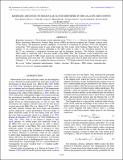KINEMATIC DISTANCES TO MOLECULAR CLOUDS IDENTIFIED IN THE GALACTIC RING SURVEY
Author(s)
Roman-Duval, Julia; Jackson, James M.; Heyer, Mark; Johnson, Alexis; Rathborne, Jill; Shah, Ronak Y.; Simon, Robert; ... Show more Show less
DownloadRoman-Duval-2009-KINEMATIC DISTANCES.pdf (1.826Mb)
PUBLISHER_POLICY
Publisher Policy
Article is made available in accordance with the publisher's policy and may be subject to US copyright law. Please refer to the publisher's site for terms of use.
Terms of use
Metadata
Show full item recordAbstract
Kinematic distances to 750 molecular clouds identified in the [superscript 13]CO J = 1 → 0 Boston University-Five College Radio Astronomy Observatory Galactic Ring Survey (GRS) are derived assuming the Clemens rotation curve of the Galaxy. The kinematic distance ambiguity is resolved by examining the presence of H I self-absorption toward the [superscript 13]CO emission peak of each cloud using the Very Large Array Galactic Plane Survey. We also identify 21 cm continuum sources embedded in the GRS clouds in order to use absorption features in the H I 21 cm continuum to distinguish between near and far kinematic distances. The Galactic distribution of GRS clouds is consistent with a four-arm model of the Milky Way. The locations of the Scutum-Crux and Perseus arms traced by GRS clouds match star-count data from the Galactic Legacy Infrared Mid-Plane Survey Extraordinaire star-count data. We conclude that molecular clouds must form in spiral arms and be short-lived (lifetimes < 10[superscript 7] yr) in order to explain the absence of massive, [superscript 13]CO bright molecular clouds in the interarm space.
Date issued
2009-07Department
Lincoln LaboratoryJournal
Astrophysical Journal
Publisher
Institute of Physics/American Astronomical Society
Citation
Roman-Duval, Julia, James M. Jackson, Mark Heyer, Alexis Johnson, Jill Rathborne, Ronak Shah, and Robert Simon. “KINEMATIC DISTANCES TO MOLECULAR CLOUDS IDENTIFIED IN THE GALACTIC RING SURVEY.” The Astrophysical Journal 699, no. 2 (June 19, 2009): 1153–1170. © 2009 American Astronomical Society.
Version: Final published version
ISSN
0004-637X
1538-4357